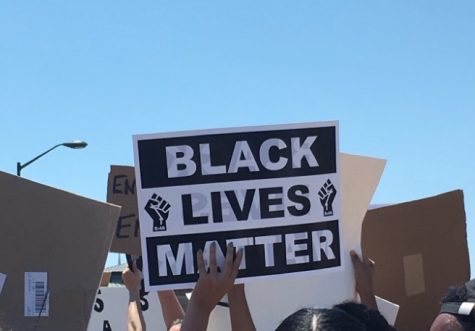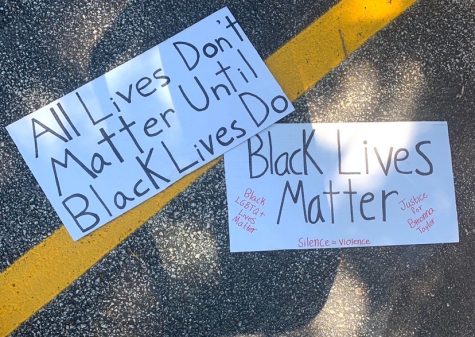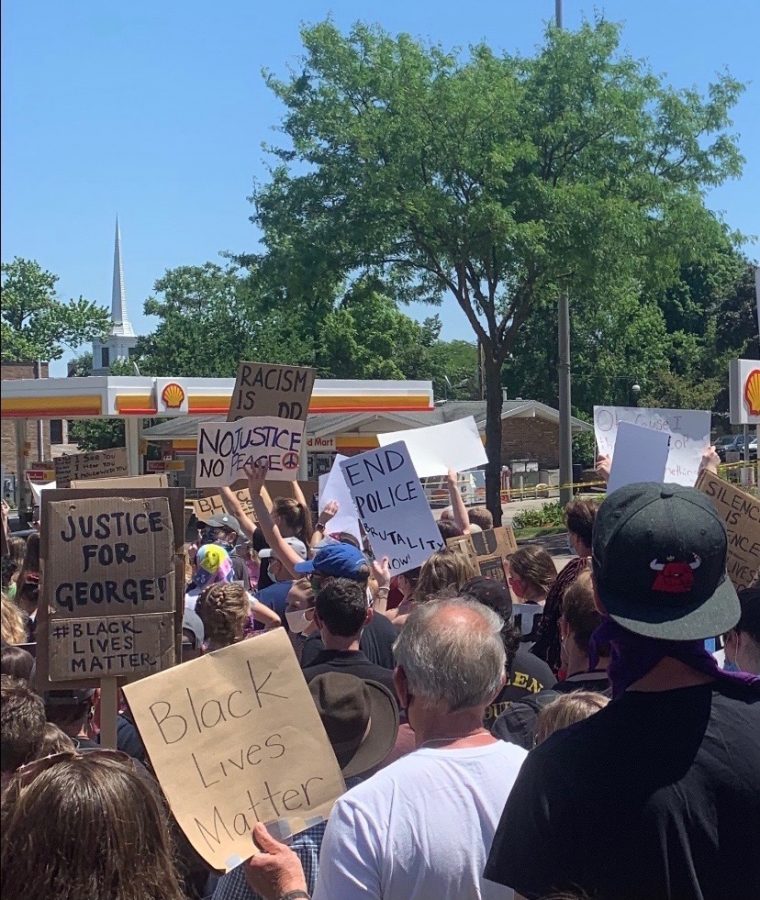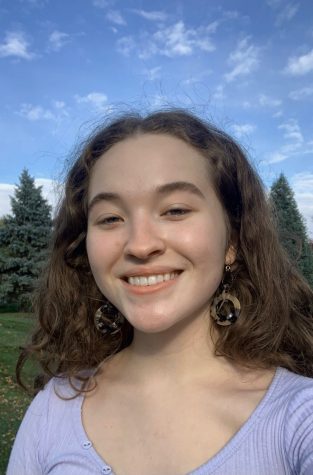Students Use Social Media to Engage Socially and Politically
Protesters walk around downtown St. Charles with BLM signs in hand.
January 15, 2021
Social media activism has grown in popularity amongst Generation Z as they use their social media accounts to spread awareness for social and political movements. A prime example of the use of social media to make change was the Black Lives Matter (BLM) movement over the summer.
In May 2020, the caught-on-camera death of George Floyd spurred a national conversation that inspired many to take action, further their education on race and reflect on the ways in which they contribute to racism. While BLM gained more attention over the summer, the organization itself has been around since 2013, and many of its ideas have been around for decades.
“A lot of people think the Black Lives Matter movement started from George Floyd being killed. It didn’t just start with that. It’s been a lot of different things that have happened over the course of decades, and this was the thing that really sparked it off,” said Kendyll Stevenson, senior.
One of the factors that set May’s revitalized BLM movement apart from ones in the past was the role social media played. Social media feeds flooded with posts in support of BLM, spreading awareness and information quickly.
“[Social media made] it easier to get information because [BLM] was getting so much attention. It was everywhere, which was really helpful to me as a person who would like to be as educated as I can about current events. The founders of the Black Lives Matter movement were all over social media, and it was very easy to really find what they were saying, which I think was really helpful,” said Louisa Olsen, senior.
Olsen wasn’t able to attend any protests over the summer because her dad is an essential worker, and due to the pandemic, her family decided that attending a protest wasn’t a safe decision for them. However, she found other ways to get involved in the movement.
“I have been making a conscious effort to buy more from black businesses, especially my books…and then signing petitions and posting on social media, as well as making donations to organizations like the NAACP Legal Defense Fund, as well as smaller groups that were paying bail for the protesters,” said Olsen.
With the pandemic limiting many people’s ability to protest in person, social media presented a unique opportunity that allowed them to stay involved and be politically active from their own homes.
Similar to Olsen, freshman Addisen Petersen was unable to attend a BLM protest, but found other ways to stay involved with the movement.
“Since [social media] is what I’m on most of the time, and lots of other people can post things about [BLM], I’m constantly seeing petitions that you can sign,” said Petersen. “I posted a bunch of [petitions] on my Instagram story, or just like anywhere that I could.”
Senior Katelyn Karner, on the other hand, was able to attend the St. Charles protest as well as strategically use social media to support the movement.

“I posted on social media a little bit. I didn’t do that much because I feel like a lot of people were. Not that like if somebody else does, you can’t post the same thing. But I was seeing a lot of the same thing. So I tried to make sure that everything I was posting was maybe a different perspective… and then I tried to sign as many petitions as possible,” said Karner.
The increase of social media activism over the summer also prompted many to question whether some people’s activism online was genuine or performative because of the ability to easily share posts to make it appear as though you support the movement without having to take action to support the movement in real life.
“I feel like a lot of people kind of use performative activism just to get them more clout on social media, or make them look like like a humanitarian or an activist, but I genuinely do think there were a lot of supporters that did everything that they could to bring attention to the issues that the black community is facing. I think people treated Black Lives Matter as a movement when the black community regards it as an ongoing thing. They just saw it as sort of like a temporary thing, which it’s not going to be if things like this continue to happen. Which they do,” said Stevenson.
The format of social media can also, at times, encourage the mindset that the BLM movement is a trend which to Stevenson is “sad to see.”
“Social media is based off of trends. So when something else starts trending, you’re no longer going to talk about that thing. And if it doesn’t affect your life, then you will just start treating [the movement] like it was a trending hashtag,” said Karner.
Following the insurrection at the Capitol on Jan. 6, the BLM posts that had become less frequent on social media made a reappearance as the riot sparked conversations about the disparity in the Capitol Police’s use of force between the Capitol riot on Jan. 6 and the BLM protests in Washington DC over the summer.
“I feel like, especially with all the stuff that’s been happening now, there needs to be more awareness brought to [BLM], especially with this stuff at the Capitol and the comparison about the raiding at the Capitol to the protests about BLM,” said Petersen.

Social media can also be very beneficial to social movements as the platforms expose people to diverse perspectives, allowing people to learn more about the issues prevalent outside of their own bubble.
“I’ve lived in South Elgin and gone to school in the St. Charles school district my whole life, where the majority of people are white, and there are especially not many black students. So, I feel like I never really experienced that kind of thing. So [social media] just gave me a much wider worldview and access to a lot more information to shape my own opinion,” said Karner.
Social media provides a diversity of opinion which can often be beneficial as it allows for interaction between people with different perspectives, providing an opportunity to bridge the gap in opinions.
“I feel like that’s why the country has become so polarized because people are comfortable being around people like them and like having their viewpoints reinforced. And I’m very open to having my viewpoints challenged or just having genuine conversations with people,” said Stevenson.
It is important to vary sources and opinions to ensure people aren’t getting only one perspective; however, some think there comes a point where topics stop being a matter of opinion and start being a human issue as politics have become more polarizing in recent years.
“There are some people that I follow on Instagram that I don’t agree with exactly…but especially with recent events, I will not follow people that I no longer think are decent human beings. If you openly support white supremacy and are posting things in support of white supremacy, or just other things that I honestly cannot think that you are a good person, if you would agree with this, I’m not gonna follow you. I’m probably going to block you. Because I don’t feel like I want to surround myself with people that want to take other people’s rights away from them,” said Olsen.
On the other hand, social media activism does have many flaws. One of them being the ability to easily spread false information.
“People can say stuff easier, without having to take accountability for what they’re saying which also means that things can be more harsh or hostile or just incorrect because you don’t necessarily know exactly where that information is coming from. Unless you can clearly see that it was from a credible source,” said Karner.
Social media has drastically changed the way in which people participate in social and political movements as its ability to make information accessible made it easy for many to find a way to take action in support of movements like the one over the summer.
“[BLM has] definitely made people more vocal…they want to be aware of what’s happening in the government…I think people have been more tuned into the government than probably ever and I think that people are being vocal about it. Especially with the election. I know, people were showing up [to the polls] in numbers that were unheard of before and I think a lot of it was due to people just spreading the word about voting…I feel like this was definitely a wake-up call for a lot of people,” said Stevenson.



